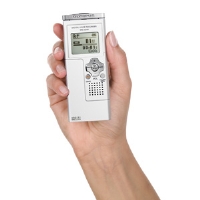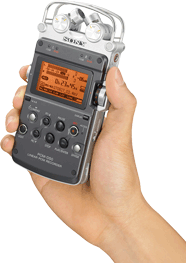I’ve been meaning, for some time, to write a post about audio recorders. Over the past few years, I’ve had the opportunity to play with use several recorders for casual and professional purposes. And I thought it would be helpful to compile a few tips and suggestions in one place. So here goes:

For interviews and non-broadcast use
For everyday recording I suggest a simple, relatively inexpensive Olympus unit, like the Olympus WS-500, similar to the unit pictured here. This device costs about $70 at Amazon.com. I have a slightly older version of this recorder. Some features:
- These devices work well for interviews, as the recorders are easy to use, non-obtrusive, and lightweight.
- They have copious amounts of internal memory, so you can record hours and hours at a time. The WS-500, for example, has 2GB of internal memory, which according to Olympus is enough for 545 hours of recording time.
- The single AAA battery lasts for a very long time — I use my Olympus several times a month and have only had to change the battery a handful of times in three years. ((One more note on batteries: Many small audio recorders, as well as larger, more sophisticated ones, use AA or AAA batteries. Environmental concerns aside, disposable batteries are preferable to rechargeable ones because you can replace disposable batteries in the field. If you’re off in the wilderness, let’s say, and your rechargeable batteries run out of juice, far from an electrical outlet, you’re out of luck.))
- For transcribing interviews, the internal speaker on units like these are fine for playback, though the device also has a jack for headphones. If you want to transfer the audio files to your computer for storage or editing, the unit has a convenient built-in USB port. For playback directly from the unit, a button allows you to listen to recordings at a slower or faster speed. This is especially helpful when transcribing interviews you’ve conducted with fast talkers. ((Also, a note about evolving technologies: In my experience, few people use mini disc recorders these days. It’s all digital, all the time. That said, I think there’s a place for older technologies. Take the simple, cheap cassette recorder. For documenting interviews, these work just fine. Cassette recorders are actually better than digital voice recorders in one way: You can look at cassette recorders and see that their wheels turning, so you know they’re functioning. Yes, digital recorders have lights that illuminate when they’re running, but sometimes — especially in hectic situations — these lights can lead to confusion. As in, is that the power light, or is the unit actually recording?))
- Note that the Olympus units record in Windows Media Audio (WMA) format. That means that if you’re on a Mac, you’ll need to use a special application to covert the WMA audio files to mp3s. I recommend the easy-to-use EasyWMA audio converter.
So how good does the audio sound? The quality you’ll get with a unit like this is fine for casual use, but the quality isn’t high enough for radio or Web broadcast. That said, you can plug an internal mic and grab some decent sound.
For example, here’s a 21-second mp3 I recorded of traffic in Hanoi a couple of years back with my trusty Olympus:
For Web or broadcast use

If you want to record audio for professional broadcast, you’ll have to spend a bit more money. For the past couple of years, I’ve been using — and really love — the Sony PCM D50.
This unit typically costs about $600. But the relatively high price tag is justified by its top-notch recordings. This model is particularly popular with radio journalists, as it’s a less expensive version of the Sony PCM D1
, which costs upward of $2000.
The PCM D50 has been out for a few years, and you can now find it on Amazon.com for $440.
Here are some of the PCM D50’s features:
- The audio quality is excellent: 96 kHz/24-bit.
- The unit has built-in dual condenser microphones that can be angled for various purposes.
- The device is rugged, with an aluminum — not plastic — shell, and though I don’t recommend treating it roughly, it can withstand some serious jostling.
- The PCM D50 has 4GB of internal memory, so there’s plenty of room for recording many hours of audio.
- The unit has an easy to use recording level dial, so that you can ensure that what you’re recording isn’t too loud.
- The unit has a divide track button, so that you can create a new track on the fly. That is, you don’t have to press stop, and then press record again. Just press divide track, and you’ll continue recording in a new track.
- The PCM D50 takes four AA batteries and records in the uncompressed WAV format, which works on PCs and Macs.
You can find reviews of the PCM D-50 here [O’Reilly], and here [Transom.org], and here [BradLinder.net]. And here’s a video review of the PCM D50 and D1.
One thing: I suggest purchasing the optional windscreen, since the mics are so sensitive that they pick up wind noise very easily, even from simply walking across a room. This windscreen is a bit pricey, at over $40, so if you don’t want to spring for the official Sony version, you can always fashion your own out of an old sock (preferably a clean one) or some other sound-absorbing material.
How does the audio sound?
For a sample of the PCM D50 in action, you can check out an audio slide show I created called scenes from Calcutta. I also used the device to create a CNNGo.cm audio slide show about chef David Thompson.
In the last few months, a new Sony model has caught my eye: the Sony PCM M10. It’s currently under $400 at Amazon.com.
Two notable features: The unit can record in mp3 format (so format conversions aren’t necessary), and it has built-in speaker, which makes for easier playback. (In order to play back audio from the PCM D50, you have to listen with headphones.) Here’s a video review of the PCM M10 on Youtube.
Perhaps, in a future post, I’ll discuss external mics and audio editing software. But I’ll leave it at this for now.
Happy recording.